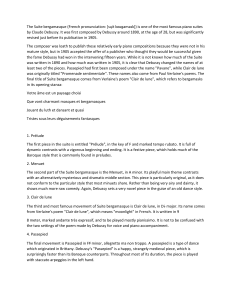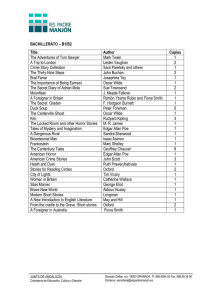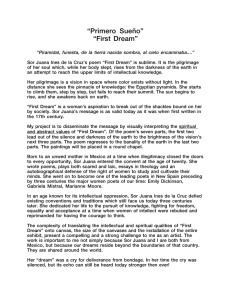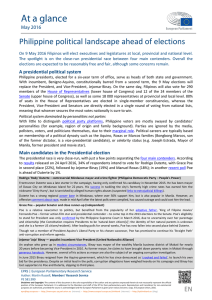Debussy's Dream Concept: Turner Parallels
Anuncio
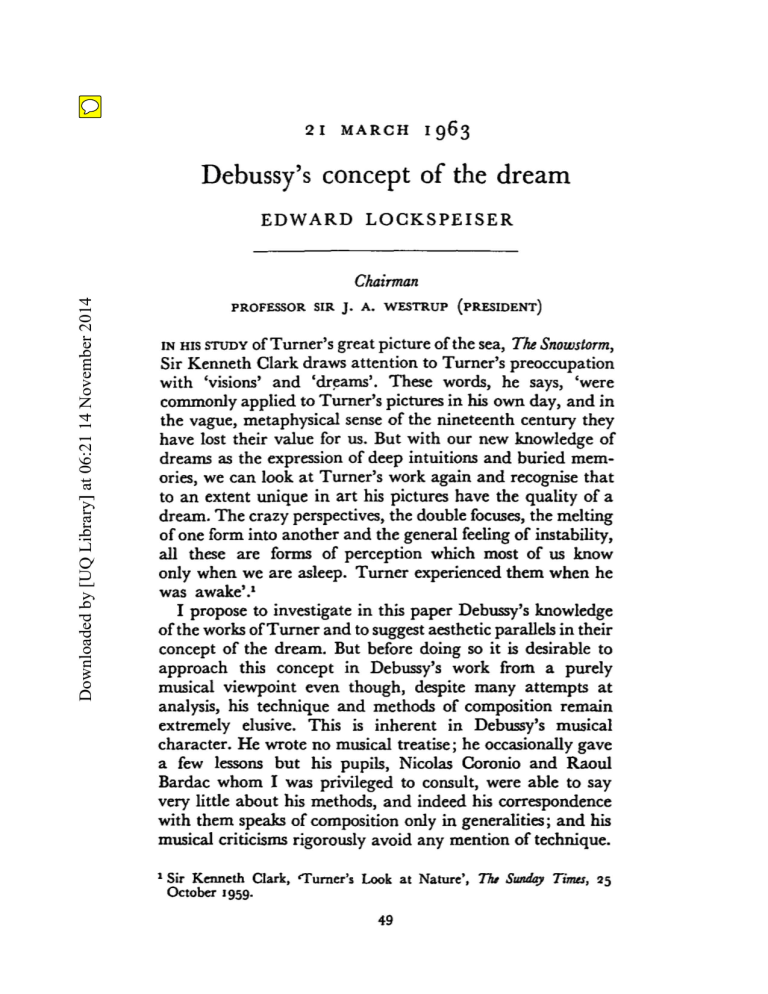
2 I
MARCH
I
963
Debussy's concept of the dream
EDWARD LOCKSPEISER
Chairman
PROFESSOR SIR
J·
A. WESTRUP (PRESIDENT)
of Turner's great picture of the sea, The Snowstorm,
Sir Kenneth Clark draws attention to Turner's preoccupation
with 'visions' and 'dr~arns'. These words, he says, 'were
commonly applied to Turner's pictures in his own day, and in
the vague, metaphysical sense of the nineteenth century they
have lost their value for us. But with our new knowledge of
dreams as the expression of deep intuitions and buried memories, we can look at Turner's work again and recognise that
to an extent unique in art his pictures have the quality of a
dream. The crazy perspectives, the double focuses, the melting
of one form into another and the general feeling of instability,
all these are forms of perception which most of us know
only when we are asleep. Turner experienced them when he
was awake'. 1
I propose to investigate in this paper Debtmy's knowledge
of the works of Turner and to suggest aesthetic parallels in their
concept of the dream. But before doing so it is desirable to
approach this concept in Debussy's work from a purely
musical viewpoint even though, despite many attempts at
analysis, his technique and methods of composition remain
extremely elusive. This is inherent in Deb1my's musical
character. He wrote no musical treatise; he occasionally gave
a few lessons but his pupils, Nicolas C,Oronio and Raoul
Bardac whom I was privileged to consult, were able to say
very little about his methods, and indeed his correspondence
with them speaks of composition only in generalities; and his
musical criticisms rigorously avoid any mention of technique.
IN HIS STUDY
1
Sir Kenneth Clark, 'Turner's Look at Nature', Thi Swulay Tunes, 25
October 1959.
49
50
DEBUSSY'S CONCEPT OF THE DREAM
We know from searching statements in Debussy's letters that
he was concerned with the power of memory, the functioning
of fantasies, the interpretation of symbols and the new significance of dreams, in particular the dream within a dream,
the labyrinth dream. These are matters which are partly
psychological and partly aesthetic, and if we try to see how
they affected his ideas on harmony, or rhythm, or form, we
are bound to confess that this new spirit that was breaking
through, this keener awareness of the life of the imaginative
mind, was so novel that any technique designed to express it
could only be evolved experimentally.
We have a valuable source, however, in the conversations
between Debussy and his former master Ernest Guiraud which
took place early in Debussy's career, and which were meticulously recorded with musical examples by Debussy's friend
and fellow pupil Maurice Emmanuel. 1 Debussy explained to
Guiraud not so much a system but an approach that should
allow for an expression of the ambiguous. He had worked out
the use of ambiguous chords, the aim of which was to undermine the rigidity of the tonal system and thus, as he believed,
to enlarge the range of harmonic experience. He argued that
since the octave consists of twenty-four semitones, twelve
ascending and twelve descending, arbitrarily reduced to
twelve to meet the requirements at the keyboard of equal
temperament, any kind of scale could in practice be built
without any allegiance to the basic C major scale. This need
not disappear, but it should be enriched by' the use of many
other scales, including the whole-tone scale and what he
cryptically calls the twenty-one note scale. (Giving each note
the name of its enharmonic counterpart, C sharp D flat, or
D sharp E flat, there are in fact twenty-one notes within the
octave.) Enharmony should be used abundantly and a plea is
made for a distinction between notes of the same enharmonic
value, that is to say between a G flat and an F sharp. The
major and minor modes are a useless convention. There
should be great freedom and flexibility in the use of major and
minor thirds, thus facilitating distant modulations, and
evasive effects should be produced by incomplete chords in
which the third is missing or other intervals are ill-defined.
' Published in A. Hofrec, lnJdits sur Debussy, Paris, 1942.
DEBUSSY'S CONCEPT OF THE DREAM
By thus blurring or drowning the sense of tonality (en noyant le
ton) a wider field of expression is ensured and seemingly
unrelated. harmonies can be approached without awkward
detours.
In illustration of this search for floating or incomplete
chords, Debussy pla ycd these successions of ninths and common
chords which, divorced from any sense of tonality, Guiraud
found theoretically unsound and meandering.
(Here was played a musical example from the notebook of
Maurice Emmanuel.•)
Such successions quickly became a commonplace, and we
may therefore have some difficulty today in seeing their
original purpose which was to create that sense of ambiguity
or of multi pie associations which, as I shall presently attempt
to show, was peculiar to the dream. The outcome of this
approach was twofold. The forms of music based on tonality
were disrupted, particularly the aspects of form concerned
with thematic development; and within the chord sequences
themselves a deliberate imprecision prevailed, (described by
Verlaine in his Art Poitique as the state in which 'findiru au
prlcis se joinf.) This presented an entirely new phenomenon.
A given note or chord in say La Cathedralt engwutie or us Sons et
ks Parfums tournent dan.r £'air du .soir may, if we wished, be
replaced by another note, another chord, without the work
suffering in an essential way. The alternative version would be
more or less beautiful but it would not shock or surprise. In the
Boston manuscript of Pellias et Milismuk' there are often
examples of single notes with many alternative versions, and
indeed at the rehearsal of this opera, when asked whether he
meant a C or a C sharp to be played, the composer himself
was not quite sure. Understandably, though he was unable
to see its significance, Saint-Saens described L'Apris-midi
d'unfllUIU as the equivalent in music not of a painting but of
the sight of an artist,s palette with its chance associations of
primary colours. 1
These features of Debussy,s musical language are we I
known. But what do they signify and what were the ideas
1
Sec Note 2.
'At the New England Conservatory of Music, Boston.
J
'Corrcspondance entrc Saint-Saens et Maurice EmmanucP, La R.ei:ut
l~luneak,
4
No. 2o6, 1947.
1t
DEBUSSY'S CONCEPT OF THE DREAM
that prompted them? As an expression of the unconscious, the
concept of the dream towards the end of the nineteenth
century was first of all a poetic concept and later, in the early
works of Freud, a scientific concept. It was not of course new;
this concept belongs in one form or another to artistic expres·
sion of all time. The novel aspect of the dream as illustrated in
the work of artists of Debussy's period, and in the work of
Debussy himself, derives from a rising to the surface of hidden
fantasies together with their symbolical and sexual significance.
The writer who principally orientated thought in this direction
was Edgar Allen Poe, who was in a sense a creation of the
French, while in French literature the outstanding figure in
this movement was Mallarme, possibly the last great poet of
the nineteenth century. The ideas of these two figures are at
the root of Debussy's inspiration.
Musicians have not been greatly concerned with the
meaning of Mallarme's poem L' Apres-midi d'un faune, held by
literary people to be the principal achievement of Symbolist
poetry. This is partly because it is a work of some obscurity,
but it is also because the music of Debussy is thought to speak
for itself and need not be referred, in detail, to the imagery of
Mallarme by which it was inspired. I do not think Mallarme's
ideas can be ignored. Mallarme's eclogue is an exploration of
the processes by which physical impulse first originates in the
imagination, is later defined in reality, and is eventually
transformed into a work of art.
Buried in its abstruse language is a philosophical treatise on
the life of the senses and the psychology of sublimation. It is
also an exploration of the borderlands between the conscious
and the half-conscious, the waking state and the state of
reverie. In his Introduction a la Psychanalyse de Mallarme'
Charles Mauron observes the deliberate confusion in L' Apresmidi between these various degrees of consciousness and
unconsciousness. The faun emerges from a dream, plays like a
child with the fantasies of his dreams, but satisfies his desires
only by plunging into sleep. The poet's art consists of never
allowing us to be quite sure if the faun is dreaming ('Aimai-je un
reve ?') or whether, when awake, he is aware of the distinction
between primitive desire and the sublimated artistic vision.
• Neuchatcl, 1950.
DEBU~Y'S CONCEPT OF THE DREAM
53
Another critic, Wallace Fowlie, similarly draws attention to a
duality of meanings in the poem. The dual meaning of the
opening line, 'Ces nymphes, je ks veux perp~tuer', this critic
suggests, represents a condensation of the entire work.
'Copulation', he explains, 'may well be one significance of the
afternoon's quest-the word 'perpetuate' is of a refined
elegance; and preservation by means of art may be the other'."
Indeed, duality of one kind or another is reflected throughout
the poem. There are two nymphs, one chaste, living on illusion,
the other experienced, sighing for love; and there are in
reality two fauns, both the lasciyious faun and the aloof,
objective faun watching himself wrestling with desire. The
faun actually addresses himself as another person. The desires
of neither are fulfilled; nor can they be since in the faun's
quest for the nymphs, as in his flute-playing, there is a con..
stant interplay between action and indolence.
There is a difference between the dreams of sleep and the
musings of reverie. The latter are considered by Mallarme to
be adolescent and even impotent. And from one viewpoint the
faun, too, is the adolescent artist anxious to make amorous
conquests but remaining more truly a poet. Here Mr. Fowlie
emphasizes that L' Apres-midi is 'MallarmC's most significant
inquest into the perplexing but omnipresent relationship
between the sexual dream world of the poet and his creative
life as a practising artist'. The imagery in the description of the
faun as an 'ingenuous lily', playing with blown-up grape skins,
his passion bursting like the purple pomegranate, is clearly
shot through with erotic associations. Yet the heart of the poem
is in a definition of sublimation. Mallarme attempts to trace in
lines, which I should like to read in French for the musicality
of the choice of words, the process in which desire first vanishes
into the dream and is then transformed into music:
Et de faire, aussi haut que l'amour se module
Evanouir du songe ordinairc de dos
Ou de ftancs purs suivis avec nos regards clos
U ne sonore, vaine et monotone ligne.
7
Wallace Fowlie, Mallann/, London, 1953.
54
DEBUSSY'S CONCEPT OF THE DREAM
In Alex Cohen's translation 1 this is rendered:
At just the height to which love modulates,
Pursuing them with veiled eyes, I'd expunge
The common dream of flank and back, to change
It to a monotone of sounding line.
I think we may see in the image of 'a sonorous, vain and
monotonous line', the origin of the flute solo at the opening of
Debussy's score. In the preceding lines the faun's fluteplaying is actually described as 'a long solo':
Qui, detournant a soi le trouble de la joue,
Reve, dans un solo long, ...
In lingering arabesques dreams of amusing
The beauty hereabout by falsely confusing
Its charm with the illusion song creates.
These lines, which bring us to the heart of Debussy's
inspiration, are interpreted by Mr. Fowlie thus: 'In the high
notes of the flute the entire experience of love may be reduced
into a single melodic line, vain and monotonous as all art is
when contrasted with the immediacy and necessity of experience. As he plays thus on his instrument, the faun is
master of himself and his feelings. He is able to follow inwardly
the dream of having seen the nudity of a nymph, her back and
side, and to sing of such a vision without experiencing the need
of acting upon it'.
(Here was played the opening
of 'L'Apres-midi d'un faune' .)
Debussy's expression of the dream is seen too in his life-long
attraction to the works of Edgar Allan Poe. Until recently it
was thought that Debussy's sketches for an opera on The Fall of
the House of Usher, were just one of the numerous ideas with
which he toyed during the latter part ofhis life. The publication
of the correspondence of Romain Rolland• allows us to form a
completely different view of this project. We learn here that as
early as 1890, three years before Pellias et Milisande, Debussy
was writing 'a symphony using psychologically developed
themes' based on The Fall of the House of Usher.
8
1
Published in E. Lockspciser, Dtbussy (Master Musicians), 1963.
Cahiers Romain Rolland, Vol. V, Paris, 1954.
DEBUSSY'S CONCEPT OF THE DREAM
55
Later this work inspired by Poe was to be an opera for the
production of which he signed a contract with Gatti Casazza
of the Metropolitan Opera in New York. 'Thorughout these
last days', he then wrote to his publisher Jacques Durand, 'I
have been busily at work on The Fall of the House of Usher. I
have found it an excellent means of strengthening one's nerves
against any form of fear. Yet there are moments when I lose
a sense of identity. When I am no longer able to perceive the
familiar objects around one, and if the sister of Roderick
Usher were suddenly to come in I shouldn't be extremely
surprised' . 10 The contract signed with the Metropolitan in
1 908 was for the production there of Usher together with the
Devil in the Belfry, another opera on a tale of Poe, in an ironic
vein on which Debussy had begun to work shortly after
Pellias in 1902.
In his study Edgar Allan Poe and France T.S. Eliot investigates
the far.reaching influence of Poe on the French literary mind
and states, 'there are aspects of Poe which English and American
critics failed to perceive' . 11 Poe was in fact almost entirely a
creation of the French-none of the writers in the rich generation
from Baudelaire to Paul Valery including Gide and Marcel
Proust escaped his fascination-and the aspect of Poe to
which they were drawn was the rising to the surface of unconscious fantasies. 'His most vivid imaginative realisations',
Eliot states, 'are the realisation of the dream'. Nearly all Poe's
tales with their dark symbolism of corridors and underground
passages, stagnant water and enveloping whirlpools, are in
essence dream tales, and although Eliot, like most other
English critics is censorious of Poe as a stylist, he does concede
that the Symbolist figures in French literature from Baudelaire
onwards saw in Poe an expression of the new sensibility that
they were themselves seeking, and that they were thus able to
interpret Poe for English writers in his true light.
Belonging entirely, in spirit and outlook, to his generation,
Debussy was similarly profoundly affected by Poe. He speaks
of the 'tyranny' the 'obsession' which Poe exerted over him. 11
Earlier critics ofDebussy, Arthur Symons and James Huneker,
drew attention to Debussy's affinity with Poe. They saw his
10
11
11
Letter of 18 June 1 go8, in Lettres <k Clawk Debussy 0. son iditeur, Paris, 192 7.
T. S. Eliot, •Edgar Poe et la France', La Table r<mde, Paris, December 1948.
Lettres inldius a Andre Caplet, edited by E. Lockspeiser, Paris, 1957.
DEBUSSY'S CONCEPT OF THE DREAM
work as a counterpart of the deliberate vagueness cultivated by
Poe, of his lugubrious moods, as a vision, too, of Poe's ethereal
women, Ligea and Morella, vanishing like MClisande before
they can be embraced.
But, of course, neither Symons nor Huneker, excellent
critics as they were, had quite the understanding of Poe's significance that we have now acquired. They were themselves part
of the movement that had sprung from this French influence of
Poe. And they were therefore unable to see, as we are today,
that the fantasies to which Debussy gave a musical expression
were almost Surrealist fantasies, the chaotic fantasies ofdreams,
such as we hear in the scene of the vaults in PelUas.
(Herewasplayedthesceneoftlzevaultsfrom'PelUasetMilisande.')
This association of Poe with Pelleas et Milisande is not
fortuitous. In the very month when he sets to work on PelUas,
in September r 893, Debussy in a letter describing his state of
mind to Ernest Chausson goes so far as to quote almost word
for word Poe's description of a sullen autumn day at the
opening of Th Howe of Usher. Poe,s tale opens: 'During the
whole of a dull, dark, and soundless day in the autumn of the
year, when the clouds hung oppr~ively low in the heavens, I
had been passing alone, on horseback., through a singularly
dreary tract of country, and at length found myself, as the
shades of evening drew on, within view of the melancholy
House of Usher'. And here is the letter of Debussy: 'It is all
very well; I cannot see beyond the sadness of the landscape of
my mind. Sometimes I pass days that are dull, dark and soundless like those of a hero of Edgar Allan Poe and I have with
this the romantic soul of a Ballade of Chopin. Solitude is
crowded with too many memories which we cannot shut out'. 11
Later in a letter to Andre Caplet we read that Poe 'although
dead exercises over me an almost agonising tyranny. I forget
the simple rules of behaviour and close myself up like a
brute beast in the House of Usher'. He told Robert Godet
that he could tell him things about Roderick Usher that would
make his beard fall off. 'You are my only friend', he
exclaims, 'alias Roderick Usher' .14
u 'Lettres ined.itcs a Ernest Chausson', La Reuue Musi&ak, Paris, December
1925.
" Lettres tk Claude Debussy a dncc amis, Paru1 1942.
DEBUSSY'S CONCEPT OF THE DREAM
57
The idea that Debussy had formed of Poe, both of his
personality and of his work, was very far from our present day
conception of him as a writer of creepy stories or as the
precursor of the crime story or the detective novel. It is clear,
from both the libretto of Usher and the musical sketches, that
Debussy was primarily concerned with the essentially soliptic
character of Roderick Usher; the enraged, self-devouring
lover guilty of loving his sister. 'Gelle que tu aimais tant', Usher
says of himself in Debussy's libretto, 'celle que tu ne devais pas
aimer' .1 r. Parent of the indecisive, Hamlet-like Pelleas, Roderick
perishes with the rise of the red moon, the same blood-red
moon, we note, that appears so dramatically at the end of
Salome and of Wozzeck, symbols in these operas, as in Usher of
love and of murder. The symbolism of this libretto with which
Debussy was so long concerned opens up an extraordinary
vision of what Debussy's art might have become had he lived
to bring fully to life Roderick's interior monologue. Because of
the illegibility of much of the musical manuscript it is difficult
to perform, but a few bars-literally a few bars-may give
some idea of its character.
(Here was played an extract from 'La Chute de la Maison
Usher'.)
It is my belief that a study of Debussy's unfinished Poe's
operas and of the ideas that they engendered offers an illuminating view of many subsequent musical developments. Not
for nothing was Poe's work the subject of an exhaustive psychoanalytic study, by Marie Bonaparte, with a preface by Freud. 11
The sexual dream visions of Poe's tales, colliding as in a
nightmare, were at the basis of works by several later writers,
among them Villiers de l'Isle Adam's Axel, a scene of which
was also set by Debussy .17
Here it is worth drawing attention to Poe's own ideas, known
to Debussy, on the nature of music. 'I know', Poe writes, 'that
indefiniteness is an element of true music ... a suggested
indefiniteness bringing about a definiteness of vague and
therefore of spiritual effect'. Commenting on this passage
The libretto and musical sketches for La Chute de la Maison Usher arc
published in Debwsy et Edgar Poe, edited by E. Lockspeiser, Paris, 1g62.
19 Marie Bonaparte, The Life and Works of Edgar Allan Poe, translated by
J. Rodkcr, London, 1949.
17 See L. Vallas, Claude Debwsy et son temps, 2nd edition, Paris, 1958.
15
58
DEBUSSY'S CONCEPT 01,. THE DREAM
Edmund Wilson, in his book The Shores of Light writes: 'The
real significance of Poe's short stories does not lie in what they
purport to relate. Many are confessedly dreams; and, as with
dreams. though they seem absurd, their effect on our emotions
is serious, And even those that pretend to the logic and the
exactitude of actual narratives are, nevertheless, also dreams ...
No one understood better than Poe that, in fiction and in
poetry both, it is not what you say that counts, but what you
make the reader feel (he always italicises the word 'effect'); no
one understood better than Poe that the deepest psychological
truth may be rendered through phantasmagoria. Even the
realistic stories of Poe are, in fact, only phantasmagoria of a
more circumstantial kind'. 111 And he concludeswithastatement
that shows at once the lasting appeal of Poe for Debussy: 'He
had elements in him that corresponded with the indefiniteness
of music and the exactitude of mathematics'.
I have dwelt on these literary origins of Debussy's concept of
the dream and you may think that this places rather too much
emphasis on this aspect of the work of Debussy who was, after
all, a musician. In fact, Debussy had no musical antecedents in
France. His friends were almost exclusively literary people, he
had strong literary leanings himself, and he was deeply
involved in the great literary movement that spread from Poe
and Baudelaire to Mallarme and to Marcel Proust and Paul
Valery. He lived, moreover, at a time when, under the impact
in France of Wagner, there was a cross-fertilisation between
the arts. The poets themselves aspired to a state of music, and
so did the Impressionist painters. In their technique they were
always using musical tenns, 'scales of colours' and 'tones'.
Debussy was greatly affected by painting-'! love pictures
almost as much as music', 11 he stated, and in regard to
pictorial representations of the dream there was one painter to
whom Debussy was particularly drawn. This was Turner
whose later works were far more revolutionary and im·
pressionistic than the later properly called Impressionist
painters, though the exact nature of his influence on the
French painters remains ill-defined. Turner is mentioned
11
11
E. Wilson, 'Poe at Home and Abroad', in The Shoru of Light, !\ew York,
J 95!2.
Unpublished letter of February, 19 n to Edgar Vartse.
DEBUSSY'S CONCEPT OF THE DREAM
59
twice in Debussy's correspondence, in 1892 and 1908, '° that is
to say, at times when few French artists, apart from Monet and
Pissarro, had any knowledge of his work. On the second
occasion Debussy refers to Turner in the superlative terms that
he uses elsewhere only for Poe. When working on the Images for
orchestra he writes: 'I am trying to achieve something
different, let us call it reality-what certain foolish people call
"Impressionism", a term used as incorrectly as possible
particularly by art critics who do not hesitate to apply it to
Turner, the greatest creator of mystery in art.' Debussy would
seem to be echoing here the well.known opinion of Ruskin
also mentioned in Debussy's writings. 11 We cannot be sure
which pictures of Turner Debussy had seen, nor where he had
seen them. But our evidence of Turner's influence in France, in
particular his reputation established there by the English art
critic, Philip Hamerton, 11 as a painter of dream visions and of
seascapes shot through with dream memories, allows us at any
rate to draw a parallel between the associations in Debussy's
numerous water pieces and those in the paintings of Turner.
At the opening of this paper I quoted Sir Kenneth Clark's
opinion that Turner's work conveyed in a unique manner the
qualities of a dream. Analysing Turner's technique in his
picture The Snowstorm, Clark suggests that in detail it recalls
the ornamentation and tradition of the arabesque in the work
of the Japanese painter, Hokusai. 'The chaos of a stormy sea',
Clark writes, 'is portrayed as accurately as if it were a bunch of
flowers'.u By a coincidence-and I do not think it can be
more than a coincidence, though it certainly illustrates a
parallel line of thought-the cover chosen by Debussy for the
published score of La Mer consists of a highly decorative
picture by Hokusai of a wave. La Mer in its wonderful sense of
detail has the same quality of the arabesque that we find in the
pictures of Hokusai, the same quality of the 'bunch of flowers'
that we may see in the details of Turner's Snowstorm, But it
also has something of the visionary drama of Turner's seascapes. Debussy uses a sense of the arabesque in the same
disturbing way. I do not think this parallel should be carried
'° Letters to Robert Godct and Jacques Durand.
11
In the unpublished play of Debussy F.E.A. (Frires en Art).
Philip Hamerton, Turner, Pans, 188g. An abridged form of this author's
The Life of J.M. W. Turner, London, 1879.
" Sir Kenneth Clark, op. ed.
11
60
DEBUSSY'S CONCEPT OF THE DREAM
further except to say that in a mind such as that of Debussy, so
receptive to both poetic and visual experiences, original
musical symbols were bound to be created by the ideas or
sights which had impressed him so deeply. These symbols in
La Mer of vortexes and whirlpools, of the gurgling backwash
and of the immensity of enveloping waves are clear enough to
us all.
(Here was played an extract from the third movement of
'La Mer'.)
Such visions have a pictorial appeal but they also contribute,
in the minds of Debussy, Poe and Turner alike, to an awareness
of certain fantasies of the unconscious. The sea is frequently
identified in modern psychology with a mother figure. 'Lamer
notre mere a tous', Debussy declared. u And there have been
many studies of the significance of water in dream poetry,
notably 'L'eau et Les reves' by Gaston Bachelard, 211 in which the
ideas of reflection and movement in water, one of the root
sources of inspiration in Symbolist poetry and Impressionist
painting, are brought to the frontiers of modern psychology.
Let me, in conclusion, quote an impression of Turner's
Snowstorm by Sir Kenneth Clark which may very well be
applied to La Mer and which goes far to helping us to understand the new provinces of the unconscious mind which
Debussy's music had conquered. I have already referred to the
'new knowledge of dreams as the expression of deep intuitions
and buried memories' which, Clark suggests, should be brought
to Turner's work. And he goes on: 'This dream-like condition
reveals itself by the repeated appearance of certain motifs
which are known to be part of the furniture of the unconscious.
One of these is the vortex or whirlpool, which became more
and more the underlying rhythm of his designs .... It is a
dream experience'. 2 • The son of a sailor who in youth had
been destined to be a sailor himself, Debussy was drawn to the
sea not only by what he refers to as his 'countless memories',
but by his imaginative conception of the sea which could not
fail to have been prompted by the seascapes of Turner and also
Letter of 18 June, 1916 to an anonymous corrcspond~t, &uue des Dewc
Mandes, 15 May, 1958.
u Paris, J 96o.
u Sir Kenneth Clark, op. cit.
H
DEBUSSY'S CONCEPT OF THE DREAM
61
by the seascapes of Poe, notably in The Narrative of Arthur
Gordon Pym. The original title of the first movement of La Mer,
Mer belle aux Iles Sanguinaires is in fact the title of a tale by
Camille Mauclair, 17 author of the two principal French
studies on Poe and on Turner. There we have it. As we look
back on the great Symbolist and Impressionist movement,
with its strong musical associations and of which Poe and
Turner were in a sense the godfathers, it was perhaps no
accident that the ideals of this movement, at any rate in its
dream aspects, were ultimately to be realised in the work of
Debussy, a musician.
17
Published in L'Eclw de Pans illustre, '27 February, 1893 .
•
